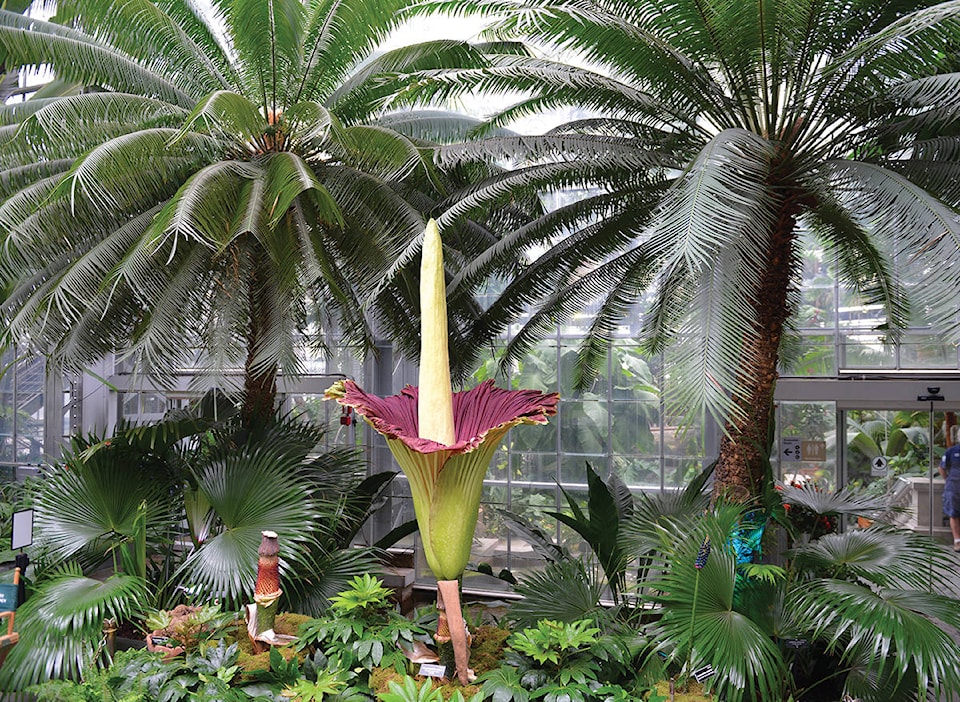The first one was dark but fleeting, the second small, broad and especially pungent. Now the third great bloom at the U.S. Botanic Garden is adding its own character to the great corpse-flower spectacle of 2017.
The last of the three trembled into flower Monday evening but early enough, unlike the others, to allow the Botanic Garden to stay open late into the evening. On Tuesday, the malodorous attraction remained in peak bloom. The garden conservatory, at 100 Maryland Ave. SW, on the west side of the Capitol, will stay open until 10 p.m. Tuesday to accommodate bloom-watchers.
The third flower opened nine days after the first and is the largest of the three. With a central spire, or spadix, at 99 1/2 inches — more than eight feet — it not only upstaged the other two but is the largest ever at the Botanic Garden, which has displayed five in recent years. In its wild setting in the Sumatran jungle, the corpse flower can reach 12 feet in height and is the world’s largest flower.
Although the second and third blooms were mother-daughter clones, the first was from entirely different genetic stock. The value of having three in a row — thought to be unprecedented in a botanical garden — is that visitors got to see the individual variation in a plant that is rare, unpredictable in its flowering and as exciting to botanists as the giant panda is to zoologists.
In addition to the variation of the three, their sequential appearance has allowed visitors to see the life cycle of the bloom, said Susan Pell, the Botanic Garden’s acting executive director. The corpse flower takes about 12 days to elongate and open and remains intact for a day or two before collapsing on itself.
The corpse flower, or titan arum, is the world’s largest unbranched inflorescence, but people want to see it as much for its smell as its size. It draws carrion beetles as pollinators in the wild and puts a great deal of its energy into generating odour and heat.
Its bloom goes through two phases. The first, when its pollen is in prime condition, is when it’s at its stinkiest. However, the second flower, which opened Aug. 22, managed to produce a fluctuating stench for as long as 40 hours, Pell said.
By early evening Monday, the third bloom had begun to unfurl its outer, encircling petal, and within a couple of hours it was beginning to waft its odour through the conservatory’s Garden Court.
It was also opening rapidly, at a speed at which slight movement could be detected in its frilled outer bloom. “You can see it move — that’s crazy,” said the Botanic Garden’s Jim Adams, observing the beast Monday evening. He came equipped with an infrared thermometer to measure the gathering heat of the spadix. He measured the bloom at around 80 degrees and expected it to increase well into the 90s as it went through its first phase.
The corpse flower, like other aroids, goes through a leaf stage before shifting into blooming. But it takes so much effort to flower that it does so only every few years, and afterward it takes several more years for the plant to re-energize. It grows from a bulblike corm, which may drop in weight from around 100 pounds to less than 40 pounds after blooming, such is the effort. (The corm from last year’s single flowering is on display alongside the others.)
Last week, Adams and his colleague Bill McLaughlin cut small holes in the spathe and used paintbrushes to transfer pollen from the first flower into the second. They are waiting to see whether the exercise worked. If it did, it will give the Botanic Garden seeds with more genetic diversity.
The corpse flower unlocks its secrets slowly and blooms when it likes, but the confluence of three together has helped the Botanic Garden’s horticulturists get a better read on predicting the sequence from when the spadix first appears to the opening of the spathe.
Among the indicators are a ribbon of purple-pink coloration along the seam of the spathe and the increase of yellow flecks within the spadix, Pell said.
She doesn’t worry that as botanic gardens get better at cultivating and blooming the corpse flower, the public’s fascination with it will diminish. “Every flowering is really different from the next,” Pell said. “I talked to a guy who had just come from seeing the eclipse, and I feel the corpse flowers are a little like that, too. They are all their own experience.”
